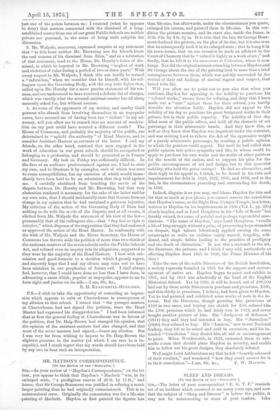MR,. HAYDON'S CORRESPONDENCE.
ere THE EDITOR OP MR "SPECTATOR."]
'S$,—In your review of " Haydon's Correspondence," on the 1st inst., you appear to think that Haydon's "Macbeth" was, in its -enlarged state, " a prodigious canvas of 20 ft. by 15 ft.," and hence, that Sir George Beaumont was justified in refusing a much larger painting than he had originally commissioned. This is an unintentional error. Originally the commission was for a life-size painting of Macbeth. Haydon at first painted the figures less than life-size, but afterwards, under the circumstances you quote, enlarged his canvas, and painted them in life-size. In this con- dition the picture remains, and its exact size, inside the frame, is
10 ft. 8 in. by 8 ft. 61 in. It is true that the late Sir George Beau- mont declined the picture, on the plea of its size, but it is also true
that he subsequently took it in its enlarged state ; that he hung it in his town-house, that on one occasion he made an affidavit in the Court of Chancery that he " valued it highly as a work of art ;" and finally, that he left it to his successors at Coleorton, where it now hangs. Nor did the original misunderstanding between Hayden and Sir George about the size of the painting lead to more than a brief estrangement between- them, which was quickly succeeded by the revival of their old feelings of mutual regard and respect, that lasted with life.
Will you allow me to point out to you also that when you condemn Hayden for appealing to the nobility to purchase his " colossal works," excuse them for refusing, and deny that I have made out a " case " against them for their refusal, you hardly describe the situation fairly. Haydon did not appeal to the nobility of his day to purchase his great Scriptural works in their private, but in their public capacity. The nobility of that day filled most of the public offices, and held all the channels of art patronage in their aristocratic hands. And they knew this, as well as they knew that Haydon was impatient under the restraint, and was striving hard to relieve the Art of the oppressive weight of a purely aristocratic patronage, by creating a public opinion to which the painters could appeal. But until he bad called that public opinion into active sympathy and life, to whom could he apply to purchase his own works and the works of other painters for the benefit of the nation, and to support his plan for the public encouragement of art and design, but to this powerful nobility, who held the purse-strings? He had no alternative, and their reply to his appeal is, I think, to be found in his ruin and imprisonment for debt in 1823, 1827, 1830, and 1836, and at the last, in the circumstances preceding and surrounding his death, in 1846.
Indeed, disguise it as you may, and blame Haydon for this and for that as much as you please, you cannot remove the conviction that Haydon's name, as the Right Hon. Cowper-Temple, in a letter, written to Haydon on his imprisonment in 1836 (Vol. I., pp. 395) clearly implies, and as Lord Houghton in his "Life of Keats " has frankly owned, is a name of painful and perhaps reproachful asso- ciations. "The name of Haydon," says Lord Houghton, "recalls a life of long struggle without a prize, of persevering hope stranded on despair, high talents laboriously applied earning the same catastrophe as waits on abilities vainly wasted, frugality, self- denial, and simple habits leading to the penalties of profligacy and the death of distraction." Is not this a reproach to the art, the literature, the patrons, and I think I may add, particularly as affecting Haydon from 1841 to 1846, the Prime Minister of his time?
Take the case of the noble Directors of the British Institution, a society expressly founded in 1805 for the support and encour- agement of native art. Haydon began to paint and exhibit in 1807, and by 1814 was admittedly at the head of the English Historical School. Yet by 1830, it will be found, out of £89,000 laid out by these noble Directors in purchase and premiums, £260, and this chiefly in premiums, I believe, had been given to Haydon. Yet he had painted and exhibited some works of note in the in- terval. But the Directors, though granting him premiums of £100 in two cases, and buying one sketch for £50, refused him the £300 premium which he had fairly won in 1812, and never bought another picture of him. His "Judgment of Solomon" (1814) they said they had intended to buy. His " Jerusalem" (1820) they refused to buy. His "Lazarus," now in our National Gallery, they left to be seized and sold in execution, and his in- tended " Crucifixion " they denied him all aid or encouragement to paint. When Wordsworth, in 1823, entreated them to sub- scribe a sum that should place Haydon in security, and enable him to follow out his great designs, they absolutely refused.
Well might Lord Ashburnham say that he felt "heartily ashamed of their conduct," and wondered " how they could answer for it to their consciences."—I am, Sir, &c., F. W. HAYDON.


































 Previous page
Previous page